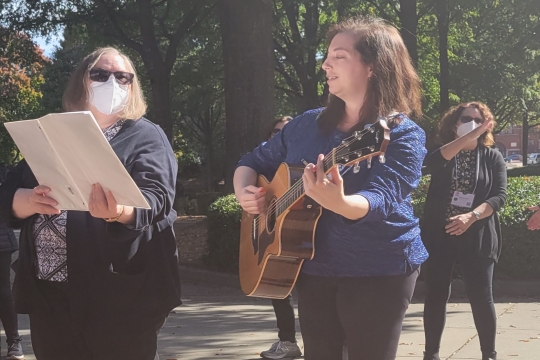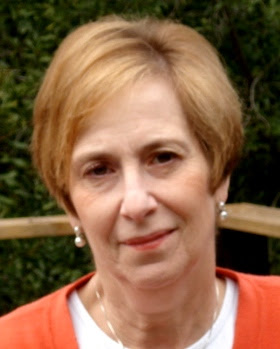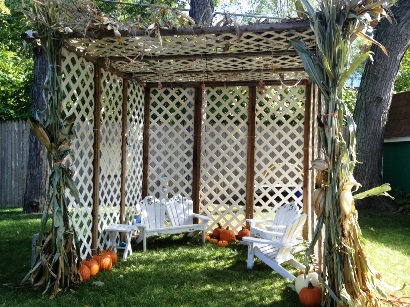
We interrupt the regular schedule of the Torah reading cycle for a special parashah –
Chol HaMo-eid Sukkot, the Torah reading for the intermediate days of Sukkah. We revisit Exodus 33:12–34:26, from Ki-Tasa, re-reading the passages containing Moses’ second trip up the mountain to get the Ten Commandments and his request to see some physical sign that God exists so that the people he is supposed to lead will be willing to follow him into the unknown. We know the rest of that story; God passes before Moses and allows Moses to see God’s back. That’s good enough for Moses! But why, you may be wondering, is this portion read during Sukkot? The portion continues with God renewing the covenant between God and the people. God makes promises, issues some thinly veiled threats, and tells Moses that the people are to observe the three festivals — including the holiday of Sukkot, the festival of the ingathering, at the turn of the year.
When my children were younger, we constructed a sukkah every year. We lived in a predominantly Orthodox neighborhood, and it was the neighborhood custom to walk from sukkah to sukkah on Shabbat, sort of like a progressive dinner. At each home, we marveled at the creativity with which the families had constructed their shelter – twinkling Christmas lights, beautiful banners, tablescapes of pumpkins and gourds. Ours was a little more plebian – my children made paper chains, and I wired their Sunday School drawings to the wall. I would bring lanterns outside to light our small sukkah, and we ate on a card table, which we dragged outside every year. I loved eating in the sukkah, inviting guests in to share our meals, and then when the dishes were done and the kids were in bed, I loved sitting in the sukkah with a glass of wine, looking at the sky through the branches carefully laid on top. Some years the sky was cloudy, and I could only glimpse a dim slice of moon. But other years, the weather was glorious, and the dark sky produced hundreds of twinkling beacons of light.
Last Friday, as I was talking to a friend after services, I mentioned that one of my favorite Shabbat evening prayers is the Hashkiveinu, the prayer which asks God to spread over us a sukkat shalom, a “sukkah of peace”—referring to the shelters with which God protected the Israelites during their forty-year sojourn in the desert, and the reason people construct those flimsy sukkahs in their back yards. Others say that the sukkah of peace refers to the cloud that sheltered the Israelites on their journey. The prayer continues by asking for protection beneath the shadow of God’s wings.
I have been thinking about that conversation a lot since we stood in the parking lot chatting. I love the rituals and prayers of Shabbat – the Shabbat candles, the smell of challah baking that permeates my house, closing my eyes and imagining the words of the Shema swirling around me like a giant tallit. Why does the Hashkiveinu appeal to me so much? On Sunday night, after Erev Rosh Hashana services, I took my glass of wine outside to my tiny patio and looked up at the stars, determined to find an answer to my question. As I gazed at that beautiful blanket of stars, I understood why that prayer is so meaningful to me.
When I sing the Hashkiveinu prayer, I am not only asking God to spread God’s shelter of peace over me, but over everyone. And, because I believe that our purpose is to be God’s partners in the world, I believe that we have the obligation to spread that sukkah of peace over everyone, not just our friends and neighbors, not just Jews -but over everyone. I thought about the times when I felt safe, cherished, and loved because I was accepted for who I am, no matter my hair color or weight or political leanings. I thought of those moments when I felt “protected under someone’s wings” because they understood what I had been through, or recognized what I had done, and spoke to my heart. Years ago, I went through a difficult divorce. My WRJ friends were there for me, offering me compassion and simply listening. Without knowing it, those women offered me what the Hashkiveinu prayer is asking for. I was surrounded by their sheltering wings. When my granddaughter calls me to say “ Bubbie, can we eat lunch together on Facetime? I don’t have anyone to have lunch with” and I respond, “of course! Just give me a minute to get something to eat!” even though it’s 3:00 in the afternoon, and I have already eaten lunch, I am spreading that sukkah of peace. When I casually chat with the transgender woman at the oneg, laughing at my ineptitude trying to hold my coffee cup and little plate, I am spreading that sukkah of peace – of safety and acceptance.
Each of us can participate in truly living the Hashkiveinu prayer, and probably has, without realizing it. Just think about the time when you invited someone else to come under your sukkah, your shelter, and the peace they felt knowing they were cared for, welcome, and safe from judgment or hurt. It could have been when you listened to a friend without judgment, offering not answers but love and care. Maybe you served food at a shelter, offering a kind smile and warm meal to someone who could not repay you, but who was clearly in need of those sheltering wings. Perhaps you participated in a congregation-wide mitzvah day, offering your heart and your volunteer hours to an organization that needed your help. I am sure you can think of other examples. In the coming year, I hope that each of us finds more opportunities to participate in this act of partnering with God to bring that sense of peace and comfort to others.
I live in a townhouse now, with no room for a flimsy temporary shelter anywhere – my patio is too small and filled with our grill and outdoor furniture, with a few plants adding the only greenery. But I still go outside at night during Sukkot and stare up at the sky. I imagine that those twinkly stars are reminders of God’s light in the world, and of the people who need us to continue our partnership with God, spreading our sukkah of peace, and opening wide our sheltering wings.
Related Posts
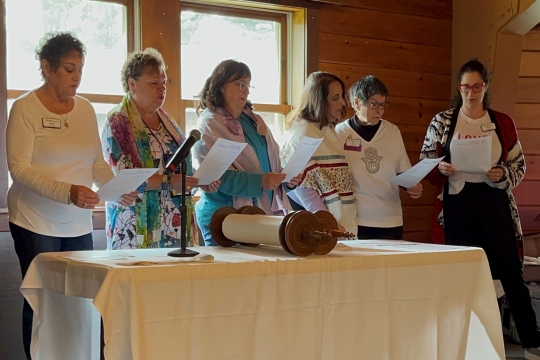
Parashat Yom Rishon shel Rosh HaShanah
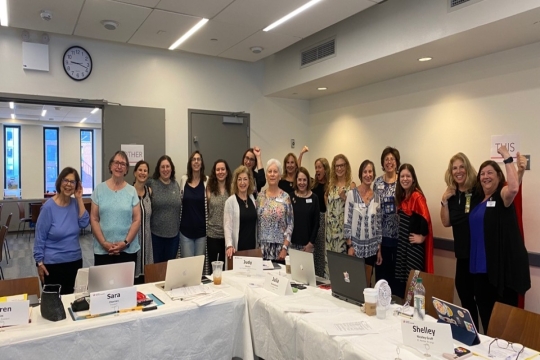
Cultivating a Culture of Accountability and Belonging
